AEEE Mock Test 2026
The Amrita Vishwa Vidyapeetham conducts the Amrita Engineering Entrance Exam (AEEE) for B.tech, which is a four-year program. Its campus is spread across various regions in India like Amritapuri, Bengaluru, Kochi, Coimbatore, and Chennai. Among all the engineering universities, Amrita University is ranked 7th for its excellent education quality and programs. You will be selected for this university by simply clearing the AEEE or the JEE mains examination. To prepare for this exam, you can attempt the AEEE mock test available on SelfStudys to get an idea of the questions that could be asked. The mock tests also help you to identify your strong and weak areas, improve your time management, and develop good test-taking strategies. We highly recommend you attempt the mock test series during your preparation journey to increase your scoring potential in the exam and get admitted into your desired engineering course.
Highlights Of The Amrita Engineering Entrance Exam
The Amrita Engineering Entrance Exam is conducted in two phases and if you have already opted in phase 1 but still want to improve your score, then you can appear in phase 2 after paying the additional exam fee. From both phases of exams, only the best score will be selected for admission into the college. For more information, you can refer to the table given below.
|
ASPECT |
DESCRIPTION |
|
|
Name of the examination |
Amrita Engineering Entrance Exam (AEEE) |
|
|
Name of the exam conducting body |
Amrita Vishwa Vidyapeetham |
|
|
Subjects for the examination |
It has four subjects
|
|
|
Examination mode |
Computer-based Test |
|
|
Frequency of the examination |
It is conducted once in a year |
|
|
Number of exam slots |
Every phase has 2 slots |
|
|
Number of questions |
100 questions |
|
|
Duration of the exam |
150 minutes (2.5 hours) |
|
|
Eligibility criteria |
10+2 (12th class) pass |
|
|
Application Fee for the AEEE |
AEEE only |
1200 |
|
AEEE + JEE |
1200 |
|
|
JEE only |
500 |
|
|
Official website |
||
Subject-Wise AEEE Mock Test Free
You can prepare for this exam with the provided AEEE mock test free that is divided into subject-wise layouts on our website. This will help you understand the difficulty level of the questions and the topics covered in particular subjects. With this feature, you can practice the topics of a subject where you have less knowledge and require more improvement. Every subject requires hard work and by attempting the mock test you can focus on the subject and its chapters separately. This exam has three major subjects: Mathematics, Physics, and Chemistry, which are available on our website for free online practice to increase your knowledge.
Solutions Included In The AEEE Mock Test 2026
The AEEE mock test 2026 on the SelfStudys platform comes with the solution to each question. All the questions are prepared by a team of experts in an easy way for you to learn the important concepts. The answers will be revealed at the end of the test so that you can check your correct and incorrect responses. Plus, you can understand the underlying concepts through step-wise explanations and recognize your weak and strong sections of the subject.
What Are The Steps To Attempt The AEEE Online Mock Test on SelfStudys?
The steps to attempt the AEEE online mock test are mentioned in detail below. You can follow them one by one and access the web page where the test is available.
- The first step you have to do is open any web browser and type www.selfstudys.com in its search section.

- You will then reach our homepage where you have to tap on the “Navigation” icon available at the left corner of the screen.

- You can see the drop-down menu with various study materials of different fields and from there, you have to select the “JEE” option.

- Scroll down on the the list and click on the “AEEE Mock Test” button.
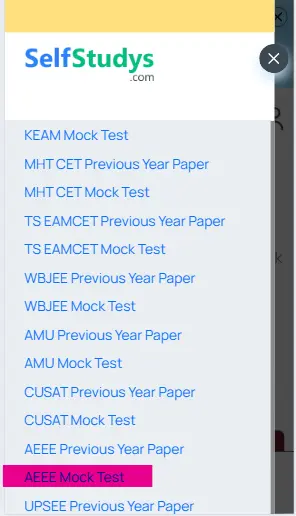
- In some time, a new page will open and you can check out the subjects of the AEEE online mock test.
- Tap on the subject for which you want to attempt the AEEE online mock test free on SelfStudys.
- After that, you can see the various AEEE mock test series and click on the “Start” icon to directly begin your test.
- At last, a pop-up will show the instructions for the AEEE mock test, read them carefully, and then start solving its questions.
Note: If you wish to know the result of your AEEE mock test 2026 attempt, then make sure to Log In or Register on SelfStudys.
Number of Questions And Marks Distribution For The Amrita Engineering Entrance Exam
The marks distribution of the AEEE is that you will get +3 marks for each correct answer and -1 for every incorrect answer. To know the number of questions that you will encounter in the exam and their marks distribution, refer to the table below:
|
Subjects |
Number of Questions |
Marks |
|
Mathematics |
40 |
120 |
|
Physics |
30 |
90 |
|
Chemistry |
25 |
75 |
|
English |
05 |
15 |
|
Total |
100 |
300 |
Syllabus From Which AEEE Online Mock Test Is Created
The detailed syllabus of all the subjects that you should study for a successful attempt at the AEEE mock test series is given in the table below. It is mentioned in a subject-wise manner so you can easily learn the topics of different subjects without any problem.
|
MATHEMATICS |
|
|
Name |
Topic |
|
Sets, Relations, and Functions |
Sets and their representation: Union, intersection and complement of sets and their algebraic properties; Power set; Relation, Type of relations, equivalence relations, functions; one-one, into and onto functions, the composition of functions. |
|
Complex Numbers |
Complex numbers in the form at and their representation on a plane. Argand diagram. Algebra of complex numbers, Modulus, and argument (or amplitude) of a complex number. |
|
Permutation and Combinations |
Fundamental principle of counting; Permutation as an arrangement and combination as selection, simple applications. |
|
Binomial theorem |
Binomial theorem for positive integral indices. General and middle terms in binomial expansions, simple applications. |
|
Sequence and series |
Arithmetic and Geometric progressions. Insertion of Arithmetic and Geometric means between two given numbers. Relation between A.M. and G.M. |
|
Matrices and Determinants |
Determinants and matrices of order two and three, Properties of determinants. Evaluation of determinants. Addition and multiplication of matrices, adjoint, and inverse of matrix. Solution of simultaneous linear equations using determinants. |
|
Quadric Equations |
Quadratic equations in real and complex number system and their solutions. Relation between roots and coefficients, Nature of roots, Formation of quadratic equations with given roots. |
|
Trigonometry |
Trigonometrical identities and equations. Inverse trigonometric functions and their properties. Properties of triangles including centroid, incentre, circumcentre, and orthocentre, Solution of triangles. Heights and distances. |
|
statistics |
Calculation of Mean, Median, and Mode of grouped and ungrouped data, Calculation of standard deviation, variance, and mean deviation for grouped and ungrouped data. |
|
Probability |
Probability of an event, addition and multiplication theorems of probability and their applications; Conditional probability; Bayes’ theorem, Probability distribution of a random variate. |
|
Limit, continuity, and differentiability |
Polynomials, rational, trigonometric, logarithmic, and exponential functions; Graphs of simple functions, Limits, and Continuity; Differentiation of the sum, difference, product, and quotient of two functions; Differentiation of trigonometric, inverse trigonometric, logarithmic, exponential, composite and implicit functions; Derivatives of order upto two, Applications of derivatives; Maxima and Minima of functions one variable, tangents and normal. |
|
Integral calculus |
Integral as an anti-derivative. Fundamental integrals involving algebraic, trigonometric, exponential and logarithmic functions; Integration by substitution, by parts and by partial fractions; Integration using trigonometric identities; Integral as a limit of sum; Properties of definite integrals. Evaluation of definite integral; Determining areas of the regions bounded by simple curves. |
|
Evaluation of definite integral |
Ordinary differential equations, their order, and degree; Formation of the differential equation; Solutions of differential equations by the method of separation of variables; Solution of Homogeneous and linear differential equations of first order. |
|
Co-ordinate Geometry |
Review of the Cartesian system of rectangular coordinates in a plane, distance formula, area of the triangle, condition for the collinearity of three points, the slope of a line, parallel and perpendicular lines, and intercepts of a line on the coordinate axes. |
|
The Straight Line and Pair of Straight Lines |
Various forms of equations of a line, intersection of lines, angles between two lines, conditions for concurrence of three lines, and distance of a point from a line. |
|
Circles and family of circles |
The standard form of the equation of a circle, the general form of the equation of a circle, its radius, and center, the equation of a circle in the parametric form, the equation of a circle when the endpoints of a diameter are given, points of intersection of a line and circle with the center at the origin. |
|
Conic Sections |
Sections of cones, equations of conic sections (parabola, ellipse, and hyperbola) in standard forms, conditions for y = mx + c to be a tangent, and point(s) of tangency. |
|
Vector Algebra |
Vector and scalars, addition of two vectors, components of a vector in two dimensions and three-dimensional space, scalar and vector products, scalar and vector triple product. Application of vectors to plane geometry. |
|
Three-Dimensional Geometry |
Distance between two points. Direction cosines of a line joining two points. Cartesian and vector equation of a line. Coplanar and skew lines. Shortest distance between two lines. Cartesian and vector equation of a plane. |
|
PHYSICS |
|
|
Units and Dimensions |
Units for measurement, system of units, SL, fundamental and derived units, dimensional analysis. |
|
Kinematics |
Uniform and non-uniform motion, average speed and instantaneous velocity, uniformly accelerated motion, velocity-time, position-time graph, relations for uniformly accelerated motion, Scalars and Vectors, Vector. Addition and subtraction, zero vector, scalar, and vector products, Unit Vector, Resolution of a Vector. Relative Velocity, Motion in a plane, Projectile Motion, Uniform Circular Motion. |
|
Mechanics |
Newton’s laws of motion, conservation of linear momentum, Friction; Work-Energy theorem, kinetic energy, potential energy, conservation of energy; elastic collision in one and two dimensions. Center of mass of a system of particles, center of mass of a rigid body, rotational motion, and torque, angular momentum and its conservation, moments of inertia for various geometries, parallel and perpendicular axes theorem. Universal law of gravitation, acceleration due to gravity, planetary motion, Kepler’s laws, Satellites, gravitational potential and potential energy and escape velocity. |
|
Solids and Fluids |
Solids: Elastic properties, Hooke’s law, Young’s modulus, bulk modulus, rigidity modulus. Liquids: Cohesion and adhesion; surface energy and surface tension; flow of fluids; Bernouli’s theorem and applications; viscosity, Stoke’s law, terminal velocity |
|
Oscillations and Waves |
Oscillations: Oscillatory motion - periodic and non-periodic motion; simple harmonic motion (SHM), angular SHM, linear harmonic oscillator — both horizontal and vertical; a combination of springs — series and parallel, simple pendulum; Expression of energy — potential energy, kinetic energy and total energy; Graphical representation of SHM. waves simple pendulum derivation of expression for its time period Wave Motion: Properties of waves; Transverse and Longitudinal, speed of traveling wave —displacement relation for a progressive wave, Superposition of waves, Progressive and Standing waves; Vibration of strings and air columns, organ pipes — fundamental mode and harmonics, beats, |
|
Heat and Thermodynamics |
Heat, work, and temperature; Ideal gas laws; Specific heat capacity, Thermal expansion of solids, liquids and gases, Relationship between Cp and Cv for gases; Newton's law of cooling, black body, Kirchoff’s law, Stafan’s law and Wein’s law, thermodynamic processes. |
|
Electrostatics, Current Electricity and Magnetostatics |
Electric charges and Fields: Electric Charge; Conductors and Insulators, Charging by Induction, Basic Properties of Electric Charge, Coulomb’s Law, Forces between Multiple Charges, Electric Field, Electric Field Lines, Electric Flux, Electric Dipole, Dipole in a Uniform External Field, Continuous Charge Distribution, Gauss’s Law, Applications of Gauss’s Law. Electrostatic potential and Capacitance: Electrostatic potential, Potential due to a point charge, electric dipole, or system of charges. Equipotential surfaces; Potential energy of a system of charges, the potential energy in an external field, Electrostatics of conductors, Dielectric and Polarization, Capacitors and Capacitance, parallel plate capacitor, the effect of dielectric on capacitance combination of capacitors, and energy stored in a capacitor. Current Electricity: Electric current, electric currents in conductors, Ohm’s law, drift of electrons and the origin of Resistivity, temperature dependence of resistivity, electrical energy, power, combination of resistors, series and parallel, cells, emf, internal resistance, cells in series and in parallel, Kirchhoff’s Rules, Wheatstone bridge, Meter bridge. Magnetic effects: BiotSavart’s law, magnetic field due to a straight wire, circular loop and solenoid, force on a moving charge in a uniform magnetic field (Lorentz force), forces and torques on a current-carrying conductor in a magnetic field, the force between current-carrying wires, moving coil galvanometer and conversion to ammeter and voltmeter. Magnetostatics: Bar magnet, magnetic field, lines of force, torque on a bar magnet in a magnetic field, earth’s magnetic field; para, dia, and ferromagnetism, magnetic induction, and magnetic susceptibility. |
|
Electromagnetic Induction and Electromagnetic Waves |
Electromagnetic Induction: Induced e. m. f: Magnetic flux, Faraday’s law, Lenz’s Law and Conservation of Energy, self and mutual inductance. Alternating Current: Impedance and reactance; power in AC circuits; AC voltage applied to a resistor, inductor, capacitor, LCR circuits and resonance, transformer, and AC generator. Electromagnetic Waves: Electromagnetic wave characteristics, electromagnetic spectrum from gamma to radio waves. |
|
Kinetic Theory of Gases |
Equation of state of a perfect gas, work done on compressing a gas, Kinetic theory of gases - assumptions, the concept of pressure. Kinetic energy and temperature: RMS speed of gas molecules: Degrees of freedom. Law of equipartition of energy, applications to specific heat capacities of gases; Mean free path. Avogadro's number. |
|
Ray and Wave Optics |
Ray Optics and optical instruments: Reflection and refraction of light by plain spherical mirrors - Total Internal Reflection; optical fiber; deviation and dispersion of light by a prism; lens formula; magnification and resolving power; microscope and telescope. Wave Optics: Huygens principle: Wave nature of light, interference of light waves and Young’s experiment, thin films, Newton’s rings, Diffraction — single slit, grating, Polarization and applications. |
|
Modern Physics |
Dual nature of radiation and matter: De Broglie relation, Electron emission, photoelectric effect, experimental study, Einstein’s photoelectric equation: Energy quantum of radiation; particle nature of light, the photon, wave nature of matter. Atoms: Alpha-particle scattering and Rutherford’s nuclear model of an atom, atomic spectra, Bohr model of the hydrogen atom; the line spectra of the hydrogen atom. Nuclei: Atomic masses and composition of the nucleus; the size of the nucleus; mass-energy and nuclear binding energy; nuclear force; radioactivity; nuclear energy Semiconductor materials, devices and simple circuits: Energy bands in solids; classification of metals, conductors and semiconductors. |
|
CHEMISTRY |
|
|
Basic Chemical Calculations |
Density - mole concept - empirical and molecular formula —stoichiometry - volumetry, equivalent and molecular masses, percentage composition |
|
Atomic Structure & Periodicity: |
Atomic models, sub-atomic particles, orbital shapes, Pauli’s exclusion, Hund’s rule, Aufbau principle, de-Broglie relation, Heisenberg’s uncertainty, electronic configuration, and periodic properties. |
|
Chemical Bonding |
ionic bonding, lattice energy — Born-haber cycle, covalent bond - Fajan’s Rule —VSEPR theory- hybridization, valence bond, and molecular orbital theory, coordinate, metallic and hydrogen bonding |
|
P-block Elements |
Boron - borax, boranes, diborane, Carbon - allotropes, oxides, carbides, halides and sulfides of carbon group- silicon and silicates — silicones, Nitrogen — Fixation —compounds of nitrogen- Phosphorous— allotropes and compounds. Oxygen - oxides and peroxide. Sulfur — its compounds - inter-halogen compounds. |
|
d and f block Elements |
d-block elements configuration and properties - transition elements, chromium, copper, zinc, silver, interstitial compounds and alloys, f-block elements and extraction, lanthanides and actinides |
|
Coordination Compounds |
Terminology in coordination- isomerism, Werner, VBT, CFT theories - Bio- coordination compounds. |
|
Solutions |
Lowering of vapor pressure, Depression of freezing point, Elevation in boiling point, Osmotic pressure, abnormality - dissociation and association |
|
Electrochemistry |
Faraday’s laws - specific, equivalent, and molar conductances, Kohlraush’s law and applications- electrode potentials - EMF, electrochemical and, galvanic cells, Nernst equation, batteries, fuel cells, corrosion and its prevention. |
|
Thermodynamics |
First and second law- internal energy, enthalpy, entropy, free energy changes- specific heats at constant pressure and constant volume — enthalpy of combustion, formation and neutralization, Kirchoff law — Hess’s law - bond energy. |
|
Equilibrium |
Law of chemical equilibrium, homogenous and heterogeneous equilibrium, Le Chatlier’s principle, equilibrium constants, factors affecting- ionic equilibrium, ionization of acids and bases, buffer solutions, pH -solubility of sparingly soluble salts. |
|
Chemical Kinetics |
Order, molecularity, rate and rate constant — first and second order reactions - temperature dependence, factors influencing the rate of reaction, integrated rate equation, collision theory of chemical reaction. |
|
Basic Organic Chemistry |
General introduction, methods of purification, qualitative and quantitative analysis, classification, and IUPAC nomenclature. Electronic effects: inductive effect, electromeric effect, resonance, and hyperconjugation. Homolytic and heterolytic fission: free radicals, carbocations, carbanions, electrophiles and nucleophiles, types of organic reactions. |
|
Hydrocarbons |
Classification of Hydrocarbons: Alkanes, Alkenes, Alkynes - Nomenclature, Structure, Methods of preparation, isomerism, conformation (ethane only), physical properties, halogenation, pyrolysis, geometrical isomerism, the addition of hydrogen, halogen, water, hydrogen halides, water to alkenes and alkynes (Markovnikov's addition and peroxide effect), ozonolysis, oxidation, mechanism of electrophilic addition, acidic character of alkynes. Aromatic Hydrocarbons: Introduction, IUPAC nomenclature, benzene: resonance, aromaticity, Chemical properties: mechanism of Nitration, sulphonation, halogenation, Friedel Craft's alkylation and acylation, directive influence of the functional group in monosubstituted benzene. Carcinogenicity and toxicity. |
|
Organic Halogen Compounds |
Nature of C-X bond- preparation - properties and reactions of alkyl and aryl halides- poly halogen compounds - substitution and elimination — mechanism-Grignard reagents |
|
ENGLISH |
|
|
Articles |
|
|
Synonyms |
|
|
Antonyms |
|
|
Preposition |
|
|
Verbs |
|
Guidelines To Attempt The Amrita Engineering Entrance Exam Computer-Based Test
Make sure you read all the guidelines carefully before taking the AEEE in the examination hall. This will help you to keep the important things in mind while attempting the questions.
- An AEEE mock test is offered on the official website of the Amrita Vishwa Vidyapeetham for you to get familiar with the computer-based test (CBT) mode.
- The examination hall where your CBT will be conducted will open 1 hour before the actual time of the exam on the specified day. And you should take your seats 30 minutes before the start of the examination.
- If you arrive late at the venue, you will likely miss the important instructions given by the invigilators. Your seat number will be allocated only in the exam hall and you will be requested to occupy your allotted seat to attempt the exam.
- You are not allowed to change rooms or exchange seats on your own and if you get caught, then no request will be accepted. Your AEEE will simply get canceled.
- You must show the admit card to the invigilator whenever they ask. Usually, it is requested at the entrance of the examination hall so that they can confirm your identification.
- Additionally, the AEEE will begin at the exact time given on the admit card and the invigilator will again check your admit card after allocating the seats.
Centers For Amrita Engineering Entrance Examination
You can check out the cities and areas where computer-based tests are held for the AEEE through the images given below.
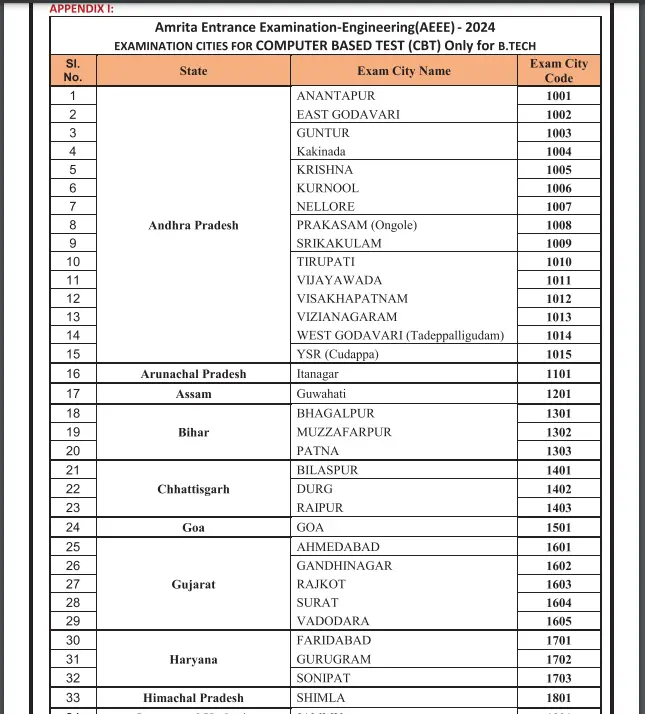
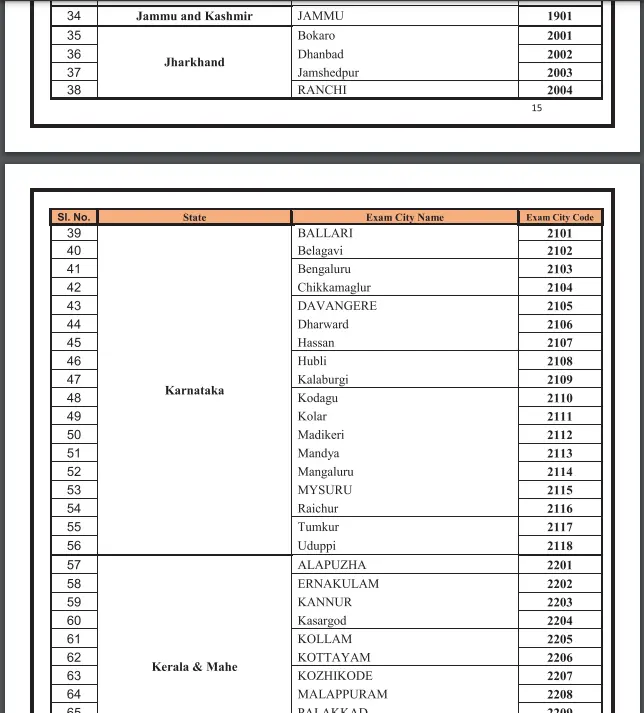

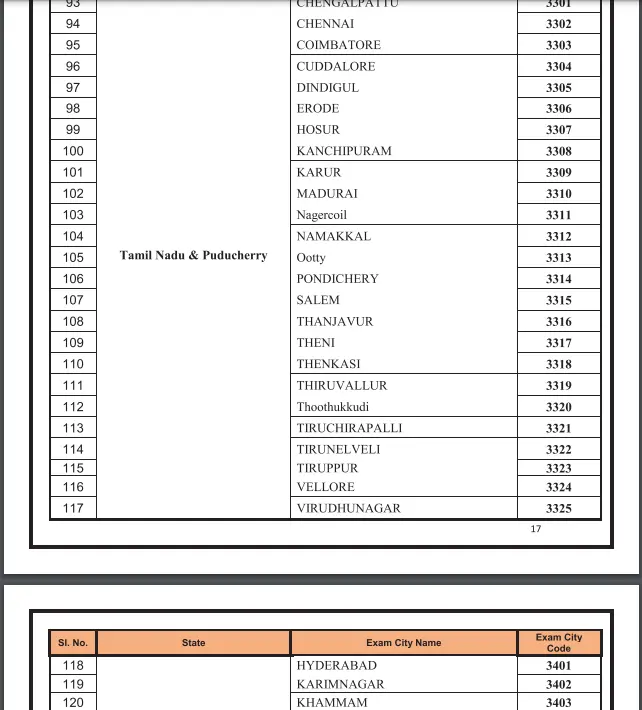
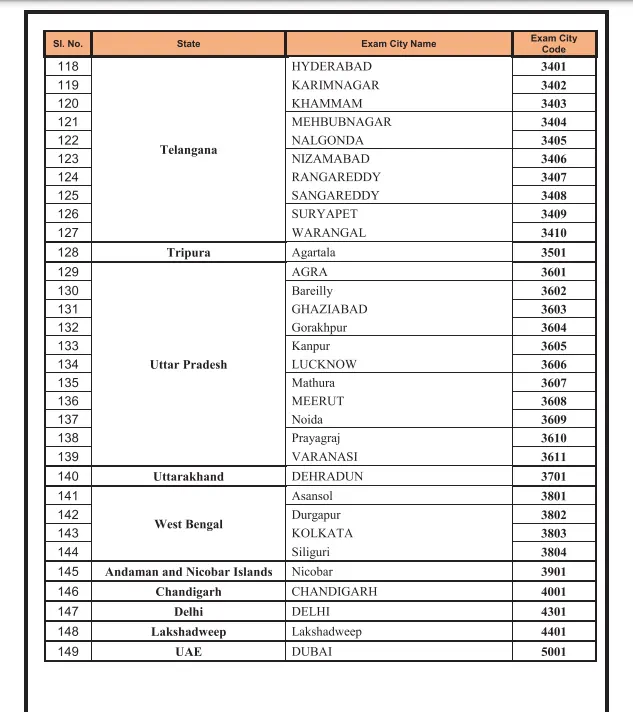
What Programs Are Offered By the Amrita Vishwa Vidyapeetham Across Various Campus?
The Amrita Vishwa Vidyapeetham has many courses for engineering students. You can check the list mentioned below to know these programs:
- Aerospace Engineering (AE)
- Artificial intelligence (AI) and Data Science (AID)
- Automation and Robotic engineering (ARE)
- Chemical Engineering (CHE)
- Civil Engineering (CE)
- Computer & Communication Engineering (CCE)
- Computer Science & Engineering (CSE)
- Computer Science & Engineering (Artificial Intelligence) (CAI)
- Computer Science & Engineering (Cyber Security-CYS)
- Electrical & Computer Engineering (ELC)
- Electrical & Electronics Engineering (EEE)
- Electronics & Communication Engineering (ECE)
- Electronics & Computer Engineering (EAC)
- Mechanical Engineering (MEE)
- Robotics and Artificial Intelligence (RAI)
Amrita Vishwa Vidyapeetham Campuses Where Different Engineering Courses Are Available
In the below chart, you can check which state’s campus is offering your course. This will help you to know where you should apply for your graduation degree.
|
Course |
Amritapuri |
Bengaluru |
Chennai |
Coimbatore |
|
Aerospace Engineering (AE) |
YES |
|||
|
Artificial intelligence (AI) and Data Science (AID) |
YES |
YES |
YES |
|
|
Automation and robotic engineering (ARE) |
YES |
YES |
||
|
Civil Engineering (CE) |
YES |
|||
|
Chemical Engineering (CHE) |
YES |
|||
|
Computer Science & Engineering (CSE) |
YES |
YES |
YES |
YES |
|
Computer Science & Engineering (Artificial Intelligence) (CAI) |
YES |
YES |
YES |
YES |
|
Computer & Communication Engineering (CCE) |
YES |
YES |
||
|
Computer Science & Engineering (Cyber Security-CYS) |
YES |
YES |
YES |
|
|
Electronics & Communication Engineering (ECE) |
YES |
YES |
YES |
YES |
|
Electrical & Electronics Engineering (EEE) |
YES |
YES |
YES |
|
|
Electronics & Computer Engineering (EAC) |
YES |
YES |
||
|
Electrical & Computer Engineering (ELC) |
YES |
YES |
YES |
|
|
Mechanical Engineering (MEE) |
YES |
YES |
YES |
YES |
|
Robotics and Artificial Intelligence (RAI) |
YES |
YES |
Note: Apart from these four colleges, the two colleges situated in Amravati and Nagercoil provide only a limited number of engineering courses from the list.
Benefits of AEEE For Amrita Vishwa Vidyapeetham Universities
You will be privileged to enter the University of Amrita Vishwa Vidyapeetham by clearing the AEEE. We have mentioned some of the benefits below so you can know the key value of the campuses.
- Entrance Into a Leading University- As you know Amrita Vishwa Vidyapeetham’s universities are the top 7th campus for engineering. So getting into the prestigious university would be great for your academic success and better future. To clear the exam with good grace, you should solve the AEEE online mock test free on our platform to understand its difficulties.
- Scholarship Opportunities- If you score high marks in the AEEE, then you will be eligible to get the scholarship given by Amrita Vishwa Vidyapeetham. Through this scholarship, you will get a reduction in tuition fees significantly with some other opportunities. You must practice hard with the AEEE mock test to get the desired scores for the scholarship.
- High-quality Infrastructure and Education- The building of the Amrita Vishwa Vidyapeetham has the modern infrastructures of the libraries, and classes that give you a wide area to conduct informative research. You can have both- practical and theoretical knowledge as well as improve your academic and personal growth.
How To Confirm The Slot For Amrita Engineering Entrance Examination?
Here are the four easy steps by which you can confirm your slot for the AEEE as per your preference.
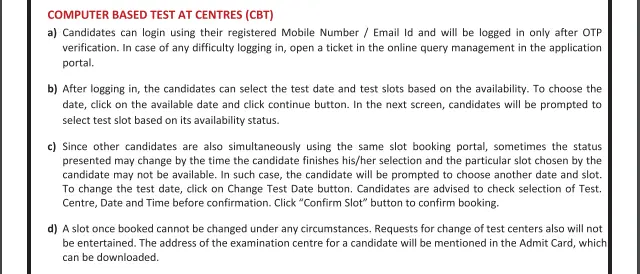
Best Books To Study For The AEEE Mock Test Preparation
In the below table, we have given you the list of the books and the names of their authors so you can prepare for the AEEE mock test free with dedication.
|
Physics Books |
Author/ Publisher |
|
Concepts of Physics |
HC Verma |
|
Comprehensive Objective Physics for Competitive Examinations |
Comprehensive Objective Physics for Competitive Examinations |
|
Mechanics Part 1 & 2 |
DC Pandey |
|
NCERT Physics |
NCERT |
|
Chemistry books |
Author/Publisher |
|
Text Books for Inorganic Chemistry for Competitions |
O P Tandon |
|
Modern Approach to Chemical Calculations |
R C Mukherjee |
|
A Guide to Mechanisms in Organic Chemistry |
Peter Sykes |
|
Numerical Chemistry 22/e |
P Bahadur |
|
Mathematics Books |
Author/Publisher |
|
Calculus and Analytical Geometry |
Thomas and Finney |
|
Problems in Calculus of One Variable |
I A Maron |
|
Coordinate Geometry for IIT-JEE |
S K Goyal |
|
Course in Mathematics for IIT-JEE |
TMH Publications |
|
English Books |
Author/Publisher |
|
Barron’s Pocket Guide to Vocabulary |
Samuel C. Brownstein |
|
High School English Grammar and Composition |
Wren & Martin |
|
Objective General English |
RS Aggarwal |
|
English is Easy |
Chetananand Singh |
What Is The Difference Between AEEE Mock Test And Previous Year Paper?
The previous year's paper and the AEEE mock test free hold different importance during the preparation journey. In the below table, you can read the difference and solve what’s best for you from our platform.
|
Aspect |
AEEE Previous Year Paper |
AEEE Mock Test |
|
Purpose |
It consists of the questions that were actually asked in the exam in the previous year. It gives you a representation of how the exam is conducted and what was the difficulty level of the questions. |
The AEEE online mock test is designed in a way where you can get an idea of the exam pattern and offers you an exam-oriented environment. |
|
Content update |
AEEE previous year's paper contains the questions which are in trend at that moment. The questions it contains can not be changed as per the recent news. It contains the syllabus of the previous year respectively. |
The AEEE mock test series content always stays up to date. It contains the latest patterns and the new topic questions. Our experts keep a check on these questions so that they can include the latest pattern and the latest changes in the syllabus. |
|
Availability |
The AEEE from previous years is often available on various platforms. You can find these at the bookstore, behind the preparation books, or even online at low cost. |
You can find the AEEE online mock test free on our platform which gives you the benefit of solving it without any cost. You just need to log in with your Google ID and start solving. |
Yes, you can solve the AEEE mock test free even if you haven’t filled out your application yet. You can use this to prepare yourself and get an idea of the difficulty level of the paper.
The time to solve the questions of the AEEE online mock test is 10 minutes on our website. You can solve it online to enhance your time management skills.
Yes, on SelfStudys, you can find the AEEE online mock test free in a subject-wise layout. This will help you to concentrate on one subject properly without any distractions.
By attempting the AEEE mock test free, you can get familiar with the questions and the exam pattern which will help you to boost your confidence for the actual exams.
You can attempt the AEEE online mock test as many times as you want. It will help you to improve your problem-solving skills and manage your time efficiently.
The AEEE online mock test free includes Physics, Chemistry, Mathematics, and English subjects.
After completing the AEEE mock test free, you will get the analysis report and result once you submit the test on our platform. With this, you can see your performance as well as assess your preparation level.
To effectively attempt the AEEE online mock test, you should practice the questions regularly, focus on the points where you are weak, and solve the questions with speed.
To attempt the AEEE online mock test free on your device, make sure you have a stable internet connection and good electricity.
No, you can’t pause AEEE mock test and resume it later on SelfStudys. So, sit tight and be prepared to attempt the test in one go.







 Profile
Profile Signout
Signout














 Quiz
Quiz
 Get latest Exam Updates
Get latest Exam Updates 










